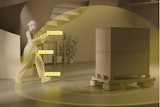At a time when energy efficiency is of utmost importance, recent developments in motor technology have changed the playing field within cooling tower HVAC systems. This new technology, a permanent magnet (PM), laminated frame direct drive motor allows for the removal of all the mechanical components such as gearboxes, drive shafts, disc couplings and existing motors. With the removal of these mechanical components you also remove their mechanical energy losses decreasing overall system energy demands. Additionally, you achieve higher motor efficiency gains with the PM technology over standard induction motor efficiencies found in the old system.
To fully appreciate the benefits of this technology it’s important to understand cooling tower application. There are typically two types of cooling towers; cross flow towers and counter flow towers. These are defined by the direction of air passed over the waste water.
A cooling tower is a structure which extracts waste heat from a process and distributes it to the atmosphere. The most common method is to let heated water fall through a moving air stream created by a fan located at the top of the tower. This evaporation takes a large amount of heat from the process. The heated water is distributed over a "fill" material, which increases the surface area the water travels on and increases the cycle time within the tower. The water is cooled as it descends through the fill. The cooled water is then collected in a cold water basin below the fill, from which it is pumped back through the process to absorb more heat.
Commonly, the size of a tower is identified by the diameter of the fan. Fan sizes range from 6 to 40 feet, with the most common applications in the 10 to 26 foot range. The speed of the fan is typically limited by industry standards for stressing, which are typically rated as a max fan tip speed of 12,000 fpm. This max tip speed generates a fan speed in the range of 147-382 rpm. The most common solution for driving the fan in current cooling tower designs utilizes a standard NEMA induction motor, driveshaft, disc couplings, and gearbox arrangement.
Cooling tower applications follow fan affinity laws which state that HP varies by the cube of the fan speed. To put this in perspective, if we had an application requiring a 40HP load at full speed, but were able to reduce the speed to 50%, due to lower heat load requirements, the application needs would only be 5HP or only 12.5% of rated full load requirements. This reflects a great reduction of energy consumption.
The use of variable frequency drives (VFDs) on new construction has become much more commonplace in recent years, due to the energy savings associated with the fan affinity laws. Additionally, most towers being upgraded or refurbished are also being equipped with VFDs. These drives have the advantage of a soft mechanical start, which means there is no large starting current draw, plus they offer ability to run the fan at any desired speed from zero to the maximum design speed for the application. The energy savings realized by using a VFD are well recognized and documented, and in case study evaluations can be shown to save 37% to 47% in energy saving as compared to applications without VFD’s.
Historically, the mechanical components of the fan drive system, specifically the right angle gearbox, have been the largest maintenance issue for cooling tower installations. Gearbox failures, oil leaks, oil contamination, failed drive shafts, misaligned drive shafts and excessive vibration are all significant problems related to this type of fan drive system.
The features and benefits of the Baldor•Reliance Direct Drive Cooling Tower Permanent Magnet (CTPM) technology have been embraced by the industry and have shown to deliver the following:
- Reduces energy Use
- Soft start capability reduces overall tower stress
- Removes alignment issues
- Removes mechanical rotating equipment
- Increase reliability
- Decreases noise levels
- Decreases yearly maintenance
- Decreases vibration levels
- Decrease ingress of contamination due to trickle current during idle periods
- Incorporates anti-wind milled option during idle periods
- Increases safety by enclosing all rotating equipment inside the tower
Many of the problems associated with cooling tower maintenance and reliability are solved with the CTPM motor design. The relatively high speed gear input shaft which typically runs at 1750rpm has been eliminated. The CTPM direct drive motor runs at the fan operating speed, which are typically slower speeds in the range of 147–382rpm. Vibration and noise concerns have been minimized. The driveshaft and associated disc couplings have been removed, thus eliminating problems associated with misalignment, natural frequencies, or delaminating of the driveshaft itself. The right angle spiral-beveled gearbox has been removed. Difficult maintenance associated with changing the oil, proper oil fill levels, contamination of the oil, oil leaks, and gearbox failures is no longer a concern.
New motor technology has led to an alternative solution, the direct drive of cooling tower fans. PM motor technology combined with the finned, laminated frame design, now allows the construction of a low speed, compact motor for use in place of the existing gearbox. Data obtained to date indicates this solution will eliminate the problems associated with the right angle gearbox and drive shaft design. By eliminating the gearbox, which is a significant source of loss in the system, improved system efficiencies can be realized.























